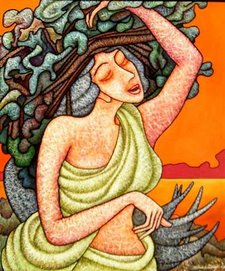
Middle East Times: June 27, 2007
Archaeologists hailed one of the most important finds in Egyptian history Wednesday after a tooth identified the 3,500-year-old mummy of Queen Hatshepsut, the most powerful female Pharaoh.
Billed as the most significant find since the discovery of King Tutankhamen's tomb in 1922, Egyptian antiquities chief Zahi Hawass made the announcement to a packed press conference in Cairo. He said that one of two mummies found in a tomb in the Valley of the Kings in Luxor about a century ago had been identified as Hatshepsut, the greatest woman monarch of the ancient world.
"The discovery of the Hatshepsut mummy is one of the most important finds in the history of Egypt," the antiquities chief said. "I'm sure that this mummy will help us to shed light on this mystery and on the mysterious nature of her death."
Hatshepsut ruled for 21 years from 1479 to 1458 BC, declaring herself Pharaoh after the death of her husband-brother Tuthmosis II.

The fabled queen, known for sporting a false beard and dressing like a man, was identified thanks to a broken tooth following examinations of four mummies from the New Kingdom using the latest forensic technology.
Hawass said that the mummy identified as Hatshepsut was of a "fat woman in her 50s who probably died of cancer."
In 1903, archaeologist Howard Carter - who later made history with his discovery of Tutankhamen - found two sarcophagi in tomb 60 in the Theban necropolis, the Valley of the Kings in Luxor.
One apparently contained the mummy of Hatshepsut's wet nurse, Sitre-In, and the other of an unknown female.
Later in 1920, he found the magnificent funerary temple of Deir Al Bahari, which Hatshepsut had built for herself at Luxor. Mysteriously, two sarcophagi found in the temple were empty.
That is where the search for Hatshepsut had ended until the US-based Discovery Channel asked Hawass to take another look.
The mummies from tomb 60 were brought to Cairo for the first time and Hawass used CT scans to produce detailed 3D images that linked physical traits of the unidentified mummy to those of Hatshepsut's heirs.
But the definitive proof, according to Hawass, was found in an ancient box inscribed with the female Pharaoh's name that was discovered in 1881 at the famous Deir Al Bahari temple, scene of a bloody massacre of tourists in 1997.
Inside the box were organs from the mummy and a tooth. Examined for its possible connection to a missing molar in the unidentified mummy from tomb 60, analysts found that it was a near-perfect match.
"Not only was the fat lady from KV-60 missing a tooth but the hole left behind and the type of tooth that was missing were an exact match for the loose one in the box," Hawass said. He said that the find could help to explain the mystery of Hatshepsut's disappearance from the ancient record after her death and the empty sarcophagi in her burial temple.
"Her reign during the 18th dynasty of ancient Egypt was a prosperous one, yet mysteriously she was erased from Egyptian history," he said.
American Egyptologist Elizabeth Thomas had first suggested years ago that the second mummy in tomb 60 belonged to Hatshepsut, because her hand was resting on her chest in a position reserved for monarchs.
Discovery said that a team of archaeologists would now carry out DNA testing on the mummy to confirm her identity.
Hatshepsut, daughter of Pharaoh Tuthmosis I who ruled from 1504 to 1484 BC, ruled before later female Pharaohs Nefertiti and Cleopatra. After the death of her husband-brother Tuthmosis II, she reigned as regent for his son by a concubine, Tuthmosis III.
Hatshepsut soon declared herself Pharaoh, donning royal headdress and a false beard. Her rule is seen as a time of stability and prosperity for Egypt. But records of her reign suddenly end after her death. Her monuments were demolished by her jealous successor, Tuthmosis III, and her mummy was thought to have been lost forever












